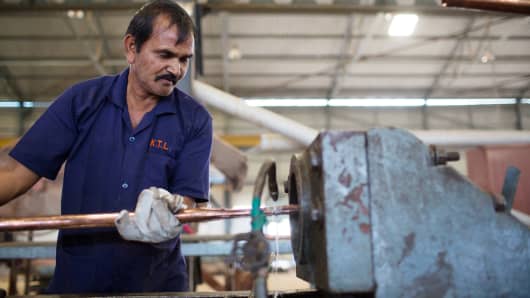Amid the latest stock market volatility, a renewed interest in diversification and rising inflation are putting more focus on commodities.
After being regarded as moribund in recent years, the category, led by precious metals, delivered positive returns in 2017 for the second straight year in a row, as measured by the broad Bloomberg Commodity Index. Many commodities staged a strong rally at year's end, making analysts even more bullish. In late January, a Goldman Sachs analyst pronounced the current environment for owning commodities as the best in decades.
A key factor driving commodities amid record-high stock valuations was diversification to fortify portfolios against a correction. Although the market entered and exited correction territory earlier this month, forecasts for this year remain bullish, mainly for the same reason that this alternative asset class performed well in 2017: the growth of most of the planet's economies. Depressed longer than the United States from the financial crisis of 2008, global economies are now rising in what economists are calling synchronized growth — and consuming commodities apace.
More from Advisor Insight:
Why investors can't gauge their own risk tolerance
Crazy tax moves clients wanted advisors to try for 2018
Don't put all your financial eggs in one investment basket
The allure of commodities as an investment is enhanced by the portfolio protection they have historically offered against inflation. Though inflation has been stubbornly low in recent years, the effects of decreasing unemployment officially registered this month with the Labor Department's report of a January jump of the core consumer prices (excluding food and energy) of 0.0345 percent — well above projections of 0.2 percent.
In addition to rising inflation and projections of continued global growth, the positive outlook for commodities for this year is supported by performance expectations for two key items. One is oil, the most widely used commodity, whose prices were edging up this year before being tamped down a bit in the correction. The other is projections for copper, a highly versatile metal considered a bellwether not only for metals and mining but for commodities in general. (Traders call it Dr. Copper because of its prescience.) Thus, copper's resilience in the correction as of mid-February is viewed as boding well for commodities overall for the coming months.
There are various ways to invest in commodities:
- Through private trading firms that store commodities that aren't consumed immediately. This includes grains, sugar, metals, coal, oil and petrochemicals and natural gas. Warehousing costs can be substantial, and high leverage isn't uncommon.
- By buying options on commodity futures. A far more common method, these are derivative investments whose returns rest on contracts seeking to predict mercurial price movements commonly affected by sudden, unpredictable trading spurts. These investments are traded on several specialized exchanges that handle investments in futures on everything from diamonds to pork bellies. The peril of commodity exchanges received popular exposure in the film Trading Places, in which Don Amici and Ralph Bellamy played ruthless traders seeking to corner the market on frozen orange juice.
- Investing in exchange-traded funds that offer shares of investment in commodity futures. On cursory inspection, this may seem a better alternative for individual investors, as it allows them to spread their investment out over multiple futures and avoids the high minimums of getting in directly. But, though more diffuse, these funds carry the same risks as direct investment.
Even when buying shares in these funds, investors are still subject to a market that could reasonably be characterized as speculation on price rather than investing in future growth. Values rise and fall entirely from trading alone, as no real value accumulates. Commodities exchanges are a rough-and-tumble environment of seasoned pros, where the average investor is a stranger in a strange land.
These pitfalls suggest a less perilous alternative for those seeking to benefit from commodities' rise: passively managed investments (ETFs abound) tracking companies that discover, develop and process commodities. Broadly classified as the materials sector, these companies can offer long-term value propositions.









